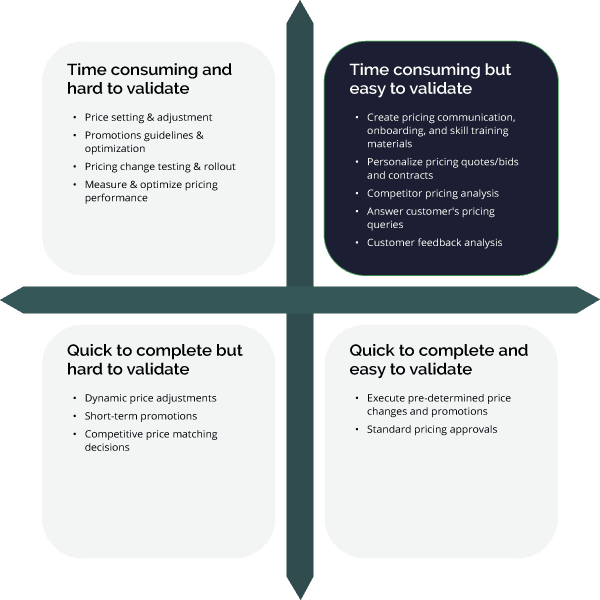Understand the trends, limits, and opportunities of generative artificial intelligence for pricing, and how it differs from current uses of artificial intelligence in pricing.
Generative Artificial Intelligence (GenAI) models have exploded in recent years and are reshaping productivity and core business practices across the board, yet its application to revenue management and growth is still being conceptualized. Where it can help is in the more administrative and day-to-day tasks that take time but are easy to validate. Yet, it is crucial – no matter how little penetration GenAI and even AI has into setting prices let alone pricing strategy – to understand the potential of GenAI and more broadly AI on revenue growth to assess its capabilities and know when and how to invest in new technologies.
What’s the difference between AI and Generative AI?
Generative AI is a specific application of artificial intelligence, using existing content and data to generate new and realistic content such as images, speech, video, text, software code and designs. The novel content does not repeat the training source material but reflects characteristics of it.
Artificial intelligence refers to the complex mathematical models that drive GenAI, and trains on massive data sets, learns to identify patterns and carries out tasks. What’s important to keep in mind is that often the use of artificial intelligence is less impressive than its perceived capabilities. Not that AI doesn’t have value for pricing but that its current application is more specific than transformative.
How is AI Currently Used in Pricing?
That said, in the past few years, AI is increasing the sophistication of pricing optimization software. It has been integrated in setting prices, such as in e-commerce pricing, making adjustments to flight and ride-sharing pricing to name a few. Where AI is proving to be most valuable is in driving business insight. It can help set the rules for knowing when to be more or less aggressive with pricing.
From a survey we commissioned in late 2023, we found that AI is already proving to be a key factor in revenue growth. More than any other category we examined, investing in artificial intelligence and machine learning pricing capabilities drove significant business results. For revenue growth alone, companies that invested in AI had a 4.79% increase versus 3.56% for all other categories grouped together.
Dynamic Pricing: Dynamic or real-time pricing is typically used for goods and services that are constantly changing in demand. Companies will use pricing software powered by AI to dynamically assess market conditions, demand fluctuations, and competitive pricing to recommend real-time adjustments, so that prices remain competitive and optimized for revenue maximization amidst changing dynamics. Essentially, AI speeds up the analytical capabilities, performing complex calculations at a speed people cannot.
Personalized Price Setting: Personalized pricing is another area with large datasets that require fast analysis. Personalized pricing tailors the price to the individual customer’s perceived value of the product and their engagement with it. The challenge to personalized pricing is data management, analysis, and storage, as well as the risk of price discrimination – purchasing a product at different prices. AI has the potential to enable businesses to execute personalized pricing at scale and at faster pace.
Promotion Guidelines & Optimization: By analyzing historical data, customer behavior, and market trends, AI can recommend more targeted and impactful promotional strategies such as tailored incentives for specific customer segments, identifying the best timing for promotions, creating dynamic promotional guidelines based on seasonality, etc.
Pricing Performance Management: AI-driven models can assess key performance indicators (KPIs) related to pricing, such as conversion rates, sales volumes, and revenue generation. By correlating these metrics with varying pricing structures, businesses can assess effectiveness of specific pricing strategies.
Immediate Opportunities for Generative Artificial Intelligence with Pricing
Traditionally, AI tools have required a trained operator and are specialized for a specific use, creating a barrier to entry for organizations. With the explosion in late 2022 of ChatGPT in the market, AI became usable by practically anyone, and for a wide variety of purposes from writing articles to designing products. As it became widely used, its limitations also became apparent, including accuracy and risks to data security. As a result, the immediate opportunities for pricing lie in activities that are time consuming but easy to validate.
Time Consuming But, Easy to Validate Activities In Pricing

- Pricing Communication Material: Natural Language Processing capability of GenAI models is transformative in crafting communication material in a fraction of time compared to a manual process. For a pricing team, it can help craft documentation for internal use that outlines pricing guidelines, strategy updates, and training materials. These documents are both time consuming to create but easy to validate and essential to ensure internal stakeholders are well-informed and aligned with pricing objectives. Externally, it can create content, such as product descriptions, pricing plans, and promotional messages and help adapt it for target audiences, channels, etc.
Impact: according to a recent sortlist survey, 43% respondents want to hire ChatGPT as a marketing copywriter for its ability to improve productivity by 50+%
- Pricing Quotes and Bids: In the domain of B2B quotes and bids, AI can assess client histories and preferences to generate personalized quotes, ensuring alignment with specific needs, and can frame contract terms that align with industry standards and client expectations.
Impact: According to a recent study, AI-enabled sales teams take 27% less time to produce a typical quote/proposal (typical time: 5 Hours) and achieve a 17% higher lead conversion rate
- Competitor pricing analysis: Large Language Models (LLM) can automate competitor price analysis and reporting process by gathering data from public sources, extracting market trends and insights, and generate summary report. Additionally, they can replace the routine price monitoring activities.
- Answer Customer’s Pricing Queries: LLMs can be used as the first touchpoint for a pricing support center, providing immediate assistance to customers on routine pricing queries while ensuring dissemination of accurate and consistent information. They can also optimize how resources are allocated by reserving human agents only for more complex and nuanced queries.
What are the potential risks of implementing GenAI in my organization?
As the initial buzz is fading, the limitations of GenAI’s capabilities are becoming apparent, invalidating, at least for the moment, that AI will soon be replacing vast numbers of jobs. For now, knowledge workers have little to fear from GenAI and will be needed to validate the work of GenAI platforms. Some of the current known issues they will need to keep a watch on are:
- Accuracy: Also known as hallucinations, the models behind GenAI programs sometimes produce incorrect or hypothetical scenarios as facts. Everything they produce need to be assessed for accuracy and usefulness before they can be distributed.
- Bias: Image recognition software is known to have issues with bias and it’s expected that these programs could experience similar issues, having been trained on large, public data sets. Having protocols in place to asses for bias are necessary as a part of the policies.
- Data-Limited: Related to bias, the programs are only as good as the prompts and the datasets they use to create the content. Training can help mitigate some of this issue but ultimately, if the information is obscure or not widely available, then the program can only do so much.
- Security Risks: As with any system that uses data, there is a risk to both the security of that data but also the use of these programs to take down your security systems.
How do I build an GenAI strategy for improving pricing capabilities?
* Pricing Survey Methodology

Executive Pricing
Survey Report
White Paper 2024 Executive Pricing Survey This year’s instalment brings an expanded viewpoint, covering a larger geographic area, and additional industries. Benchmark your 2023 Pricing
About our Editorial Team
Our articles are all written based on the research, experience, and input of our pricing and revenue management experts. They have multiple years of experience in consulting and on the client side. Each article also goes through a thorough review process and validated.




